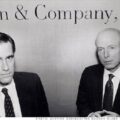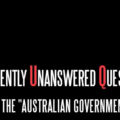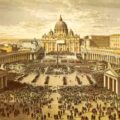By Jimmy Mengel, Outsider Club
“Facts do not cease to exist because they are ignored.” — Aldous Huxley
So who really controls the world?
The Illuminati? Freemasons? The Bilderberg Group?
Or are these all red herrings to distract your prying eyes from the real global elite? The answer, like most topics worth exploring, is not quite so simple. Have no doubt, there aresecretive global powers whose only goal is to keep and grow that power. But it really may not be as secretive as you’d think. And that’s what makes it even more nefarious…
But don’t take my word for it, we have both science and insider testimony to back it up…
We’re going to break this down into three categories: Financial, Political and Media. This is a harder task than you may imagine, since they all work in concert by design.
Financial Elite
Thanks to the science of complex system theory, the answer may actually be right in front of our faces.
This scientific process sheds light on the dark corners of bank control and international finance and pulls some of the major players out from the shadows.
And it goes back to the old credo: Just follow the money…
Systems theorist James B. Glattfelder did just that.
From a massive database of 37 million companies, Glattfelder pulled out the 43,060 transnational corporations (companies that operate in more than one country) that are all connected by their shareholders.
Digging further, he constructed a model that actually displays just how connected these companies are to one another through ownership of shares and their corresponding operating revenues.

The 1318 transnational corporations that form the core of the economy.
Superconnected companies are red, very connected companies are yellow. The size of the dot represents revenue.
I’ll openly admit that this graphic almost scared me off. Complex scientific theories are not my forte, and this looks like some sort of intergalactic snow globe.
But Glattfelder has done a remarkable job of boiling these connections down to the main actors — as well as pinpointing how much power they have over the global market. These “ownership networks” can reveal who the key players are, how they are organized, and exactly how interconnected these powers are.
From New Scientist: Each of the 1318 had ties to two or more other companies, and on average they were connected to 20. What’s more, although they represented 20 per cent of global operating revenues, the 1318 appeared to collectively own through their shares the majority of the world’s large blue chip and manufacturing firms — the “real” economy — representing a further 60 per cent of global revenues.
When the team further untangled the web of ownership, it found much of it tracked back to a “super-entity” of 147 even more tightly knit companies — all of their ownership was held by other members of the super-entity — that controlled 40 per cent of the total wealth in the network.
According to his data, Glattfelder found that the top 730 shareholders control a whopping 80% of the entire revenue of transnational corporations.
And — surprise, surprise! — they are mostly financial institutions in the United States and the United Kingdom.
That is a huge amount of concentrated control in a small number of hands…
Here are the top ten transnational companies that hold the most control over the global economy (and if you are one of the millions that are convinced Big Banks run the world, you should get a creeping sense of validation from this list):
1) Barclays plc
2) Capital Group Companies Inc.
3) FMR Corporation
4) AXA
5) State Street Corporation
6) JPMorgan Chase & Co.
7) Legal & General Group plc
8) Vanguard Group Inc.
9) UBS AG
10) Merrill Lynch & Co Inc.
Some of the other usual suspects round out the top 25, including JP Morgan, UBS, Credit Suisse, and Goldman Sachs.
What you won’t find are ExxonMobil, Microsoft, or General Electric, which I found shocking. In fact, you have to scroll all the way down to China Petrochemical Group Company at number 50 to find a company that actually creates something.
The top 49 corporations are financial institutions, banks, and insurance companies — with the exception of Wal-Mart, which ranks at number 15…
The rest essentially just push money around to one another.
Here’s the interconnectedness of the top players in this international scheme:

Here’s a fun fact about the number one player, Barclays:
Barclays was a main player in the LIBOR manipulation scandal, and were found to have committed fraud and collusion with other interconnected big banks. They were fined $200 million by the Commodity Futures Trading Commission, $160 million by the United States Department of Justice and £59.5 million by the Financial Services Authority for “attempted manipulation” of the Libor and Euribor rates.
Despite their crimes, Barclays still paid $61,781,950 in bonuses earlier this year, including a whopping $27,371,750 to investment banking head Rich Ricci. And yes, that’s actually his real name…
These are the guys that run the world.
It’s essentially the “too big to fail” argument laid out in a scientific setting — only instead of just the U.S. banks, we’re talking about an international cabal of banks and financial institutions so intertwined that they pose a serious threat to global economics.
And instead of “too big to fail,” we’re looking at “too connected to fail”…
Glattfelder contends that “a high degree of interconnectivity can be bad for stability, because stress can spread through the system like an epidemic.”
Industrialist Henry Ford once quipped, “It is well enough that people of the nation do not understand our banking and money system, for if they did, I believe there would be a revolution before tomorrow morning.”
It’s one thing to have suspicions that someone is working behind the scenes to control the world’s money supply. It’s quite another to have scientific evidence that clearly supports it.
But these guys can only exist within a political system that supports their goals. And those political systems are pretty much operating in the open…
POLITCAL ELITE
For the sake of brevity, let’s cut right to the chase. Every major geopolitical decision of the last few decades has been run through one of these three organizations: the Trilateral Commission, the Council on Foreign Relations and the World Bank/International Monetary Fund (IMF).
The Trilateral Commission
In 1973, the infamous David Rockefeller created a group of the world’s power brokers to work together — outside of any official governmental or political allegiance — to bring about cooperation of North America, Western Europe and Japan.
They launched under the guise of working together to solve the world’s problems. A noble goal — but “problems” are very subjective.
Here’s the rundown of members:
The North American continent is represented by 120 members (20 Canadian, 13 Mexican and 87 U.S. citizens). The European group has reached its limit of 170 members from almost every country on the continent; the ceilings for individual countries are 20 for Germany, 18 for France, Italy and the United Kingdom, 12 for Spain and 1–6 for the rest. At first, Asia and Oceania were represented only by Japan. However, in 2000 the Japanese group of 85 members expanded itself, becoming the Pacific Asia group, composed of 117 members: 75 Japanese, 11 South Koreans, 7 Australian and New Zealand citizens, and 15 members from the ASEAN nations (Indonesia, Malaysia, Philippines, Singapore and Thailand). The Pacific Asia group also included 9 members from China, Hong Kong and Taiwan. Currently, the Trilateral Commission claims “more than 100″ Pacific Asian members.
It’s a global who’s-who of power brokers. And while the Trilateral Commission excludes anyone currently holding public office from membership, it serves as a revolving door of the rich and powerful from the financial, political and academic elite.
Most suspicions of the group began during the Jimmy Carter administration, when Carter — himself a member of the Trilateral Commission — made Zbigniew Brzezinski his National Security advisor. Brzezinski was the Trilateral Commission’s first executive director. Carter’s Vice President Walter Mondale was also a member.
And perhaps most importantly, Trilateral member Paul Volker served as Carter’s Chair of the Federal Reserve. He is still the North American Honorary Chairman.
Such a concentration of power in a U.S. president’s cabinet obviously made people nervous,
Notable recent additions include Austan Goolsbe — former chairman for Obama’s Council of Economic Advisors. I’d suggest you familiarize yourselves with the entire member list here.
You’ll be shocked at who else is part of this secretive organization.
Follow the Outsider Club for Part II of this important subject.
One Bank to Rule Them All: World Bank Whistle-blower Reveals Bank Conspiracy
By Jimmy Mengel, Outsider Club
If you had any doubt, we now have science and first-hand testimony to prove it.
Note: This is not some wild conspiracy theory. It’s systems theory, a serious scientific discipline, used by researcher James B. Gladfelder to prove that a small group of banks essentially control the world’s finances.
Gladfelder’s research proved that the top 730 shareholders control a whopping 80% of the entire revenue of transnational corporations.
But the truth is the global banking elite simply cannot maintain a stranglehold on the world’s power all by themselves. And so, while they run off with the money, their lackeys in the political sphere acts as gatekeepers.
Again, we’re not relying on labyrinthine explanations and vague fears of domination; we’re looking at the matter through scientific discipline and actual admissions from the power brokers themselves.
The fact is we simply cannot talk about global control without talking about the World Bank…
The World Bank represents 188 different countries from Albania to Zimbabwe. However, it is controlled by a small number of powerful countries, each with its own serious economic interests.
Since there is no voting for the leadership and chief economists at the bank, the United States and other large countries have complete control to appoint who they’d like to do their bidding — and they have appointed some highly questionable folks to run the behemoth:
Robert McNamara – JFK’s former secretary of defense and president of Ford Motor Company was chosen to lead the Bank in 1968, fresh off his disastrous handling of the Vietnam War.
Lewis T. Preston – a bank executive with J.P. Morgan. We all know J.P. Morgan doesn’t have the interest of the working poor at heart, as evidenced by years of abuse of regular folks, culminating in their record $13 billion fine this year.
Robert Zoellick – a bank executive with Goldman Sachs. Again, if the head of Goldman Sachs is at the helm, you know the bidding of the powerful will get its due… After all, you don’t earn a nickname like “The Great Vampire Squid” for your altruism.
Paul Wolfowitz – Much like McNamara, Wolfowitz was handed the reigns to the World Bank after helping orchestrate George Bush’s outrageous war on Iraq. While president of the Bank, he gave his girlfriend massive pay raises — more than double what she was entitled to! The fact that the head of the World Bank could engage in such petty corruption doesn’t bode well for the bank at large, considering the immense power they wield. Wolfowitz was eventually forced to resign.
Perhaps more alarmingly, the World Bank also receives complete immunity from any and all countries it does “business” with, so it cannot be held legally accountable for its actions.
The United States has complete veto power over the Bank’s actions as well, which it can use to block any action by the Bank that may threaten national interests — and the interests of the global financial powers that control them.
The World Bank’s stated purpose is to help poor and developing countries by providing loans.
The catch? To obtain one of these loans, you have to comply with the Bank’s draconian wish lists.
Examples of the conditions countries must meet to gain access to a loan include suppressing wages, cutting programs like education and health care, and easing limits on foreign investment.
How do the results stack up with its stated mission?
Not well. In fact, data shows most countries that have taken the World Bank’s money and agreed to its terms are no better off today then they were when they received their first loan — and many are actually worse off.
From the Heritage Foundation:
Of the 66 less-developed countries receiving money from the World Bank for more than 25 years (most for more than 30 years), 37 are no better off today than they were before they received such loans.
Of these 37 countries, most (20 in all) are actually poorer today than they were before receiving aid from the Bank.
Former less-developed countries that have prospered over the past 30 years did so by freeing up the productive forces of their economies. The best examples are Hong Kong and Singapore: Even though a country like Singapore received a small amount of money from the World Bank, the evidence shows that what most affected economic growth was not World Bank aid, but economic freedom.
What’s more, an ex-World Bank employee described something far more nefarious than ineptitude…
Karen Hudes watched first-hand as the World Bank manipulated and covered up corruption in its economic development projects.
It’s important to know Hudes wasn’t some disgruntled lackey; she served as Senior Counsel and worked for the bank for 20 years. During those two decades at the World Bank, Hudes saw systematic and widespread corruption.
“It’s a mafia,” she told the New American.
“These culprits that have grabbed all this economic power have succeeded in infiltrating both sides of the issue, so you will find people who are supposedly trying to fight corruption who are just there to spread disinformation and as a placeholder to trip up anybody who manages to get their act together. Those thugs think that if they can keep the world ignorant, they can bleed it longer.”
Hudes saw large-scale enrichment of the powerful, while the poor the Bank was supposed to be helping were getting stiffed.
“I realized we were now dealing with something known as state capture, which is where the institutions of government are co-opted by the group that’s corrupt,” she noted.
Hudes was eventually fired after she spoke out against the Bank’s attempt to cover up a botched bailout of a crooked bank in the Philippines.
Here are a few choice examples of what happens to the $2.5 billion in U.S. taxpayer money that is funneled into the World Bank each and every year, from the American Enterprise Institute:
38 countries have amassed $71 billion in unpayable multilateral loans, encouraged by the Bank’s self-serving projections of country growth, on which rich-country taxpayers must now make good.
Corruption has been exposed both within the World Bank and in its programs, and is now estimated at more than $100 billion.
Protest is rising among leading African scholars who seek to stop all aid because it serves only to entrench and enrich a series of corrupt elites. Massive anecdotal evidence of waste, ineptitude, and outright theft can no longer be ignored.
Not exactly the poverty-fighting superhero the institution makes itself out to be.
The World Bank works in conjunction with the International Monetary Fund, which operates in the same vein of enriching Wall Street and supporting dictators. We’ll pull the curtain back on the IMF next week.
See more from Jimmy Mengel at the Outsider Club
Jimmy is a managing editor for Outsider Club and the Investment Director of the personal finance advisory The Crow’s Nest. You may also know him as the architect behind the wildly popular finance and investing website Wealth Wire, where he’s brought readers the stories behind the mainstream financial news each and every day. For more on Jimmy, check out his editor’s page.







Brings to mind and makes perfect sense now..of Bush’s Points of Light that he introduced with such a benevolent tone.. That tone..? that.. makes me more and more suspicious now a days ..when I hear it..